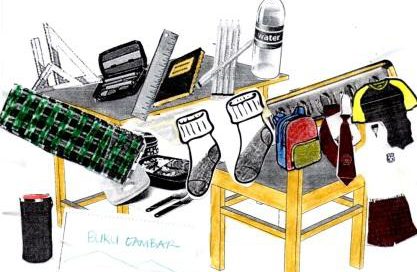
Keep up with our latest news and projects!

Our participatory workshop programme comprised of a series of creative interior workshops which were conducted in a primary school in Depok, West Java, Indonesia. Through these workshops, we intended to encourage the children to think creatively beyond the existing environment that they had. On the other hand, we encouraged children to participate and engage in designing their everyday space. The existing condition of school classroom and school furniture in Indonesia generally is not very conducive to creative learning needs. The typical classroom setting in primary schools usually consists of rows of chairs and desks, which tend to be heavy and thus difficult to rearrange and reorganise for dynamic learning activities. The students are forced to sit with this array of chairs and desks throughout the school day. Storage spaces and shelves tend to have ergonomically inappropriate dimensions for primary school children. Besides, there is a lack of medium for children’s expression and interaction that is necessary to enhance the development of creativity in the classroom. Hence, we intended to involve the primary school children in generating ideas for an innovative school classroom and school furniture participation workshop.
Participatory workshops on classroom interiors and classroom furniture become opportunities for a creative learning process that incorporate three important aspects: creativity, everydayness and communication/ collaboration. The children learn to be creative by imagining ideas, making and composing elements to generate their creative ideas.
The workshop also enhances the children’s understanding of their everydayness by learning to identify their own needs in daily activities in school, by organising and arranging objects and spaces to respond to their needs. The children used their creative imagination to respond to the needs and issues that they experience in their daily life in school (Claxton et al, 2006) and they used their own ways of seeing the environment and the possibilities in it (Burke and Grosvenor, 2003).
The creative collage below indicated that children generated the ideas about how they put their personal belongings in relation to their chair and desk. The children offered various creative ideas, such as: putting the drawer under the desk to store their lunch box and personal stationery,
The participatory workshops also become a medium for learning how to communicate and collaborate, which are also essential parts of the creative process (Fasko, 2001). During the workshops, the children were required to explain their ideas and their works (both the collages and models) through various media: telling stories to their peers in the group, presenting in front of the classroom, and writing. The workshops encouraged children to exercise their communication skills, by describing and explaining their own creative ideas. It became an exercise for their development of language skills, especially in telling stories and writing descriptive texts. In this way, the workshops could become a medium to integrate knowledge and skills in different subjects, especially arts and language.
The participatory workshop also focused on the introduction of interior architecture knowledge and skills in the context of classroom spaces and furniture. It might be possible to extend the approach into other contexts of children’s everyday settings, such as home, library, healthcare centre or public space setting like an area of a neighbourhood. Each of the settings might involve different spatial needs and issues and thus require different approaches to respond to those needs and issues.
From the previous workshop on classroom furniture and classroom interior experience, we could learn that the children were asked to identify their needs for various activities. In the neighbourhood park, children could be encouraged to recognise their body position and their particular active movement when they are playing. Even, they could imagine the ideas about adding other activities which are usually performed inside, for example reading and doing a science experiment. Those creative ideas from the children could add various unimaginable features in the street furniture and object in our neighbourhood area.

On the neighbourhood scale, children are the main actors that engage with everyday experience in using the public object and public furniture in the neighbourhood area. However, the dimension and the function of the public furniture are commonly not suitable for the children’s utility and ergonomic. Public furniture should become creative learning tools that could support creative learning through playing process and allow the children to express their creativity within the neighbourhood area. Therefore, we attempt to involve children to generate the ideas of innovative street furniture and urban interior object of a neighbourhood park that express their ingenious and imaginative ideas through a creative approach.
This article belongs to a series of stories about the city at eye level for kids! You can access the full book online in PDF or pre-order your hardcopy to be delivered to your home.
Get your book here